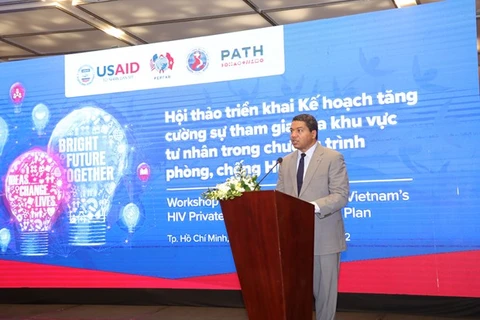On October 15, 2012, the Prime Minister issued a decision approving a plan on ensuring finance for anti-HIV/AIDS activities for the 2013 - 2020 period.
Deputy Minister of Health Nguyen Thi Lien Huong said HIV/AIDS prevention and control is the only medical programme in Vietnam to have a particular decision made by the PM to give guidance on finance guaranteeing mechanism. The plan created an important legal corridor for taking measures to ensure sustainable funding for the HIV/AIDS fight.
Thanks to the strong political commitment of all-level administrations, the close coordination in policy making among ministries and sectors, as well as technical and financial support from sponsors, Vietnam has reaped many impressive results during the transition of financial resources for the work, she noted.
The proportion of domestic financial sources has risen to over 51%. In particular, localities’ allocation of their budgets for HIV/AIDS prevention and control has continually increased, from 8% to nearly 17% during 2012 - 2020.
The proportion of the fund to total spending on HIV/AIDS has increased to 9% from 4%, accounting for 25% of domestic resources for the HIV combat.
Through the national programme on HIV/AIDS prevention and control and the anti-HIV/AIDS project under the national health care and population target programme, allocations from the central budget for provinces and cities in this regard have made up nearly 10%. The share of other private sources has also reached 8%, according to the official.
However, Huong also pointed out the difficulties facing Vietnam in the transition of financial resources for the HIV/AIDS combat. For example, resources set to be mobilised during 2021 - 2030 have met just 60 - 70% of demand, the number of HIV-infected persons has increased in the last three years, and nearly 50% of the funding for anti-HIV/AIDS activities still depends on international projects.
Under the National Strategy on putting an end to AIDS in 2030 which has been approved by government, the rate of high-risk people accessing HIV prevention services is expected to reach 80%, and that of people living with HIV knowing their conditions, 95 percent.
The scheme also aims for 95% of HIV carriers to receive antiretroviral (ARV) drug. Mother-to-child infection is expected to be wiped out in 2030.
Meanwhile, the HIV prevention and control capacity in the medical system at all levels will be enhanced, and the personnel and financial resources for the work ensured.
The strategy gives 11 major solutions to complete the goals, including those on offering treatment and care for people living with HIV.
The coverage of HIV/AIDS treatment services will be expanded through the offering of ARV to them right after they are diagnosed with the virus, and extending the treatment for patients in prisons, reformatories and other social facilities.
Private healthcare facilities will be encouraged to play a role in HIV/AIDS treatment, and community-based treatment services also expanded. Alongside, pregnant women will receive HIV consultations and testing.
Besides, HIV/AIDS treatment quality will be improved through updating latest recommendations in the field, ensuring safety and efficiency of the therapy.
Statistics from the Department of HIV/AIDS Prevention and Control under the Ministry of Health showed that about 242,000 people are living with HIV in Vietnam. Up to 112,368 have so far died of the syndrome.
In the first nine months of the year, 9,025 people were found positive to the virus, of which 1,378 have died. The number of infections was high in the southern provinces, especially in Ho Chi Minh City and the Mekong River Delta with 28% and 26%, respectively./.
























